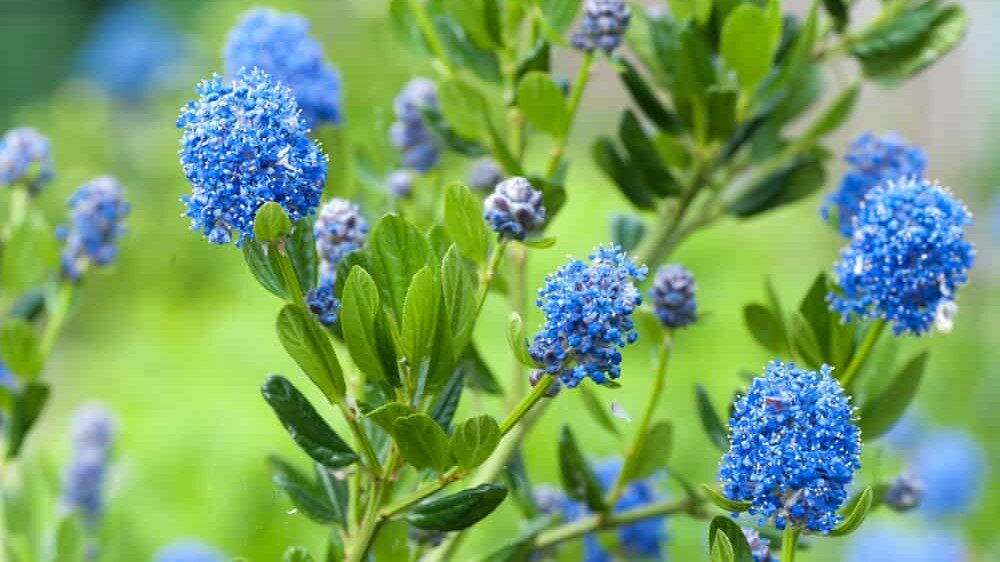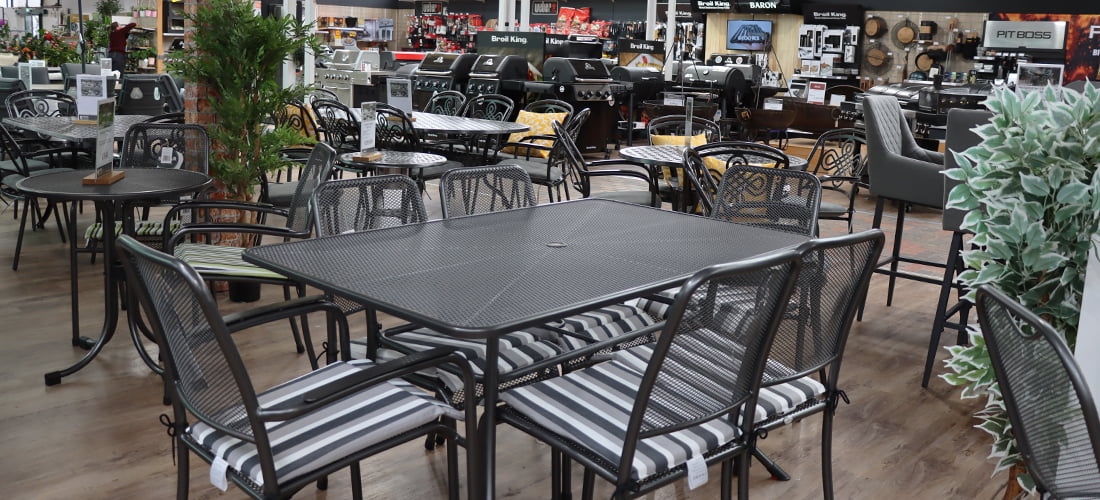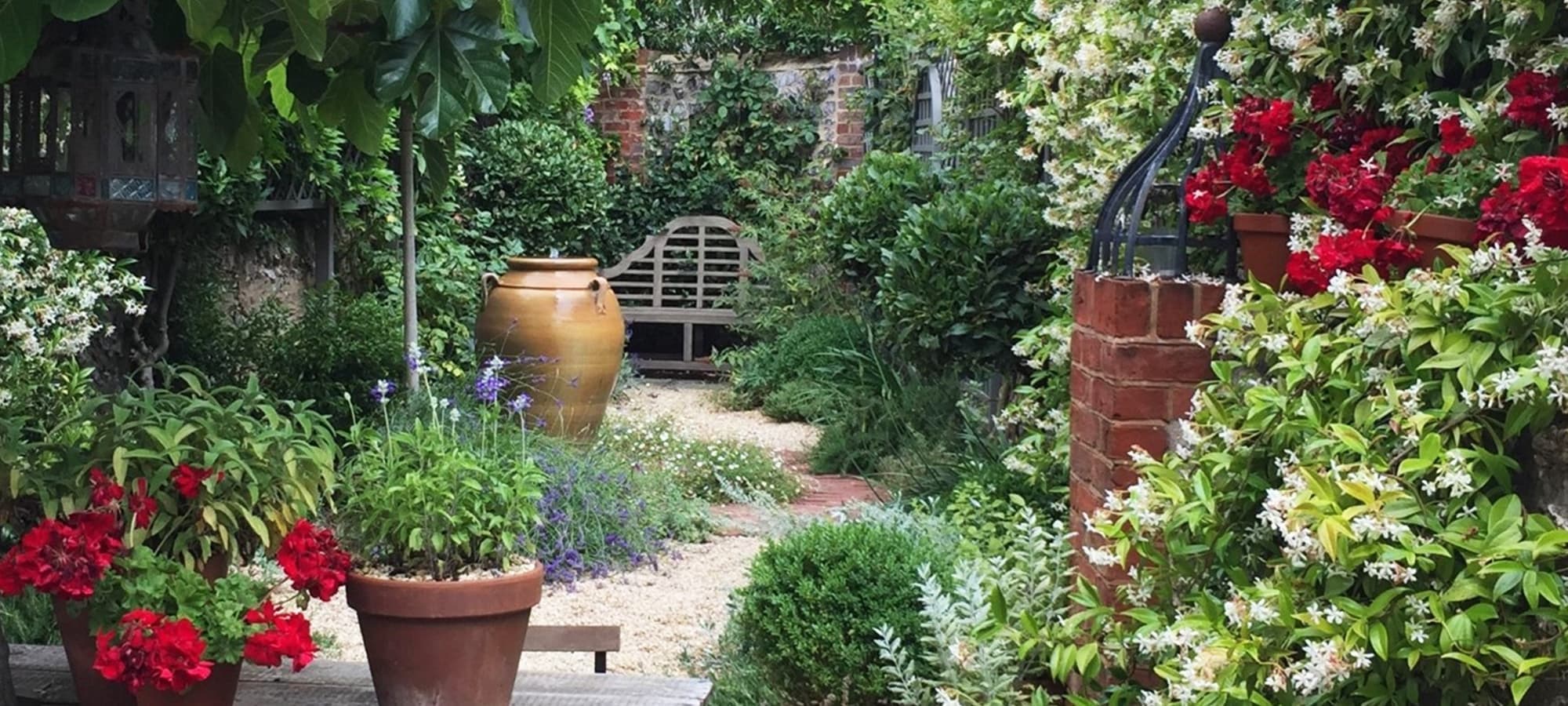Any garden, large or small, will benefit from some climbers. Whether covering walls or fences, arbors or obelisks, or just weaving through trees and shrubs, climbers can create and enhance the vertical dimension of the garden, especially where ground space is limited. Climbers are especially useful for screening unsightly walls or fences or for softening stark surfaces, creating a leafy backdrop that blends in with the rest of the garden.
Sunny walls and fences are a bonus to the gardener as they offer warmth and shelter for less hardy plants, and support for shrubs with trailing or fragile stems. Most will greatly increase their average height when grown against a wall. Others may not need the warmth for protection but to help ripen the fruit. Sunless walls and fences need not be a problem as long as they receive some light. Many shrubs will thrive, and some even prefer the normally cooler conditions of such a site
SOIL PREPERATION
Careful soil preparation should be carried out, digging at least to a depth of 25cm or more and mixing in good quantities of organic compost such as well-rotted farmyard manure, spent mushroom compost, garden com-post or a proprietary planting compost.
PLANTING DISTANCE
The wall shrub, when planted, should be at least 40-50cm away from the wall or fence to allow for growth of the stem and also to ensure there is a good supply of moisture for the roots. Feeding with a general fertilizer in the spring will ensure that the shrub has adequate nutrients for the coming season.
Most wall shrubs have the advantage over climbing plants by being able, with a little help, to cover an area from ground level to as high as required to form a dense cover for a wall or fence.
WATERING
Without a supply of water plants die as they are unable to keep cool and absorb food. Some shrubs and trees are more susceptible to drought than others and extra care must be taken.
Follow this up with annual mulches of manure, compost or bark when the soil is moist, and you will eventually have an ideal growing medium.
HOW TO ENSURE ADEQUATE WATER
Soil preparation prior to planting is very important, and if plants are to be grown in containers the right potting compost must be used. Soil should be dug as deep as is practical and between 25-50cm is normally ideal. Digging lets in air, as well as water, to prevent root suffocation.
Water-retaining polymer granules can be added to compost or soil prior to planting but be careful to follow the manufacturers recommendations closely.
Adding Organic Materials
Mulching
Watering Cans
Applying Water
Sprinklers
Trickle or Soaking Hoses
Trickle or soaking hoses may be used which allow very small amounts of water to be delivered over an extended period of time.
Alternatively a more permanent sprinkler system can be installed.
Root Watering
In the garden 5-8cm diameter pipes or plastic soft drink bottles with the bottoms cut off can be sunk in the soil alongside trees or shrubs, particularly when they are planted as large specimens. These should be topped up with water on a regular basis.
Many of the plants mentioned below can be viewed on our Plant Finder.
ANNUALS FOR SUNNY ASPECTS
- Cobaea scandens (Cup & Saucer Plant/Cathedral Bells): Vigorous climber with purple or white bells. 4m.
- Convolvulus major: Very refined form of ‘Bindweed’ which is non-invasive and has Petunia-like flowers. 3m.
- Gourds: Something different which succeed well in full sun and manure rich soil. Up to 8m.
- Ipomea (Morning Glory): Bright blue, blue and white, purple or even red trumpet flowers for East aspects. 3m.
- Lathyrus (Sweetpea): Ideal for sunny positions. Many colours inc. white, pink and deep red perennials. Annual ‘Spencer’ varieties are the most fragrant. 3m.
- Mina lobota: Spectacular red, fading to orange, tubular flowers with protruding stamens. 5-7m.
- Rhodochiton atrosanguineum: Dark purple parachute-like bells for a warm position. 2m.
- Thunbergia (Black Eyed Susan): Orange, yellow or white flowers sometimes with a chocolate centre. Also trail. 1m.
- Tropaeolum majus (Nasturtium): Familiar yellow, orange or red single or semi-double flowers. 3m.
- Tropaeolum peregrinum (Canary Creeper): Yellow distinctive flowers. Can be perennial in favoured spots. 4m.
PERENNIALS FOR SOUTH AND WEST ASPECTS
Abutilon megapotanicum: Red and yellow bell-shaped flowers for months. Fairly hardy 2-3.5m.
- Actinidia kolomikta: leaves on mature plants tipped with silver, later pink. Male and female on separate plants. Fragrant round white flowers. 4-8m.
- Akebia quinata (Chocolate Vine): fragrant reddish-purple flowers, followed by large chocolate coloured fruits.
- Acacia dealbata (Mimosa): grey-green leaves, yellow clustered flowerheads. Lemon-like scent. 10m+.
- Actinidia kolmikta: Hardy climber for full sun to succeed. Slender and elegant, grown for its large green heart shaped leaves which can become cream and pink variegated if enough sun. 3-4m.
- Buddleja crispa: racemes of small, pale lavender flowers from mid-late summer. Felty grey-green oval leaves. 3m.
- Callistemon pallidas (Bottlebrush): silvery or red young shoots. Cream or pale yellow flowers, in semi-open “bottlebrush” spikes late spring to midsummer, followed by woody fruit capsules. 2-4m.
- Campsis radicans (Bignonia/Trumpet Vine): Fairly vigorous with wide mouthed orange or scarlet trumpet
- flowers. Other Campsis varieties not reliably hardy.
- Ceanothus (Californian Lilac): Mostly small leaved blue flowering shrubs and climbers. 3.5m x 3m.
- Celastrus (Bittersweet): clusters of small greenish-yellow flowers. Pea sized orange & scarlet vessels with seeds.
- Chionanthus praecox (Wintersweet): shiny dark green leaves. Yellow-green & reddish-purple flowers borne in winter. Highly fragrant. 2.5m+.
- Clematis: All types succeed in sunny aspects provided the roots are in the shade and head is in the sun. Some types with coloured bars fade in sunny positions. Various heights.
- Cytisus battandieri (Moroccan Broom): Erect and fast-growing. Grey furry leaves and yellow pineapple-scented flower spikes. 3m x 2m.
- Eccremocarpus (Chilean Glory Flower): Fern-like leaves with racemes of long orange-red tubular flowers. 3m.
- Fremontodendron californicum (Californian Glory): Upright self-supporter with bright golden cup-shaped flowers all summer. Needs well drained position. Train branches flat to keep in width. 3-4m x 2m.
- Humulus aurea (Golden Hop): Long twining stems with deeply lobed soft yellow leaves. Vigorous to 3m.
- Itea ilicifolia: Thin holly-like leaves with small greenish-white fragrant flowers in Catkin-like racemes. 3m x 1.5m.
- Jasminum (Jasmine): The slightly more tender forms like J. beesianum/aureo ‘Marginata’ will succeed.
- Lavatera maritima (Tree Mallow): downy grey leaves and stems. Pink/lilac flowers with purple veins and eye.
- Lonicera (Honeysuckle): May varieties that grow well in a sunny spot provided the roots are shaded. Many produce bright red berries.
- Magnolia grandiflora ‘Exmouth’ (Goliath): Fine large polished leaves and cream flowering ‘Goblets’. 5m x 3m.
- Passiflora caerulea (Passion Flower): The hardiest form with spectacular ‘crowned’ flowers followed by orange egg-shaped edible fruits. 4m x 3m.
- Phygelius (Cape Figuort): Ovate leaves with miniature scarlet ‘hunting horns’ on spinelike stems. 3-4m.
- Ribes speciosum (Fuchsia-flowered Gooseberry): bristly stems with glossy leaves. Small, fuchsia-like flowers in mid-late spring
- Robinia hispida (Rose Acacia): bristly branches. Short racemes of deep pink flowers late spring-early summer.
- Rosa (Rose): Climbers and ramblers are ideal for sunny aspects and associate well with Clematis.
- Rosa x odorata ‘Mutabilis’ (China Rose): open, lax growth, with purplish young foliage and almost thornless stems. Single flowers buff-yellow, ageing to pink and crimson.
- Senecio scandens : Untidy ‘scrambler’ with grey-green foliage and yellow daisies. 3m.
- Trachelospermum jasminoides: Very fragrant white Jasmine flowers in mid-summer. Lime hater. 4-8m.
- Wisteria: Many varieties, quickly cover walls, pergolas, sheds and quite tall trees. Take 3-5 years to flower. 10m.
PERENNIALS FOR NORTH AND EAST ASPECTS
- Akebia quinata (Chocolate Vine): purple flowers and dark fruits. Vigorous if happy. Up to 8m.
- Azara microphylla: small, glossy dark green leaves. Small clusters of yellow, vanilla-scented flowers from late spring. Occasionally produces red berries.
- Camellia: Avoid early morning sun which damage the rose-like blossoms after frost. Hardy lime haters. Not scented.
- Chaenomeles (Japanese Quince): Red/pink/white flowers early spring & autumn. Quinces ideal for making jelly. 1.5m.
- Clematis: Some types will succeed in semi-shade although tending only to flower towards the top.
- Cotoneaster horizontalis: ‘fishbone’ patterned self-supporting climbers with red berries. 1.5m x 3m
- Cotoneaster lacteus: Larger glossy more pointed leaves. Orange berries. 2.5m x 3m.
- Euonymus fortunei: Although ground coverers, these will climb if forced against a fence or tree. 2-3m x 1.5m.
- Forsythia suspensa: Golden yellow flowers in March/April. Easy to grow. 3-5m x 5m.
- Garrya elliptica: Dark shiny tough leaves and long silky grey or pink catkins in winter. 3m x 2.5m.
- Hedera (Ivy): Variegated or green leaved. 3m x 3m.
- Hydrangea petiolaris (Climbing Hydrangea): Flat heads of white flowers smother plants June/July. 3m x 4m.
- Ilex (Holly): Any tall growing varieties can be trained to stiffly climb. Need partner to berry. 3m x 1m.
- Jasminum (Jasmine): Familiar climbers. Winter and summer varieties.
- Kerria japonica ‘Pleniflora’: Double buttercup flowers. ■
- Lonicera (Honeysuckle): Popular twiners, with a large variety of colours available.
- Parthenoccissus (Boston Ivy): with vine-like leaves. Dazzling hues in autumn.
- Piptanthus nepalensis (Evergreen Laburnum): blue-green leaves, short racemes of 4cm yellow flowers late spring-early summer, followed by flat green pods.
- Polygonum baldschuanicum (Mile-A-Minute Russian Vine): The most vigorous climber with frothy cream panicles rom July to October. Grows up to 6m a season but can be very hard pruned. 12m.
- Pyracantha (Firethorn): White flat-headed summer flowers followed by red, orange or yellow berries. 4m x 3m.
- Ribes laurifolium (Laurel-leaved Currant): Yellow-green flowers in pendent racemes late winter-early spring. Female plants produce red fruits ripening to black.
- Rosa (Rose): Most roses need a sunny spot but many are suitable for more shaded positions.
- Viburnum tinus (Laurustinus): dark green, oval leaves. Long-flowering clusters of small, creamy-white flowers, often pink-tinged in bud, late winter & spring. Followed by blue-black berries. 3m.
- Vinca (Periwinkle): These white or purple trailers and ground coverers can also be trained to climb. 3m.
- Weigela: Many different options of varying colours, fragrance & height.
TRAINED FRUIT IN VARIOUS ASPECTS
- Actinidia chinensis (Chinese Gooseberry/Kiwi): Vigorous climber which fruits against a sunny wall.
- Apple: Many varieties are available in cordon, espalier or fantrained forms for sunny positions.
- Apricot: Fan-train on warm walls for cropping in sunny summers in the south. Self pollinators.
- Blackberry: Plant against fences or up poles and space 1.8m – 2.5m apart in a sunny or part shaded position. Many modern varieties are thornless.
- Cherry: Self fertile. Morello can be fan trained and is invaluable for northern aspects.
- Ficus (Fig): Plant near a warm wall in a sunny position. ‘Brown Turkey’ is the most commonly grown.
- Loganberry: Can be grown against a sunny fence. Choose modern thornless varieties.
- Nectarine: Carefully site these self-fertile fruits against a warm wall to crop in warm summers in the south.
- Peach: As for Apricots and Nectarines.
- Pear: Many varieties are available in cordon, espalier or fan trained forms for sunny positions.
- Plum/Gage: Some varieties are available as, or can be, fan trained. Usually self-fertile.
- Vitis (Grapevines): Ideal for growing against warm walls or fences. We offer a large selection of outdoor and indoor grapes.
These unique cultivars undergo 10 years of trial and assessment to guarantee reliable, free flowering and top performing clematis best suited to modern gardens.








